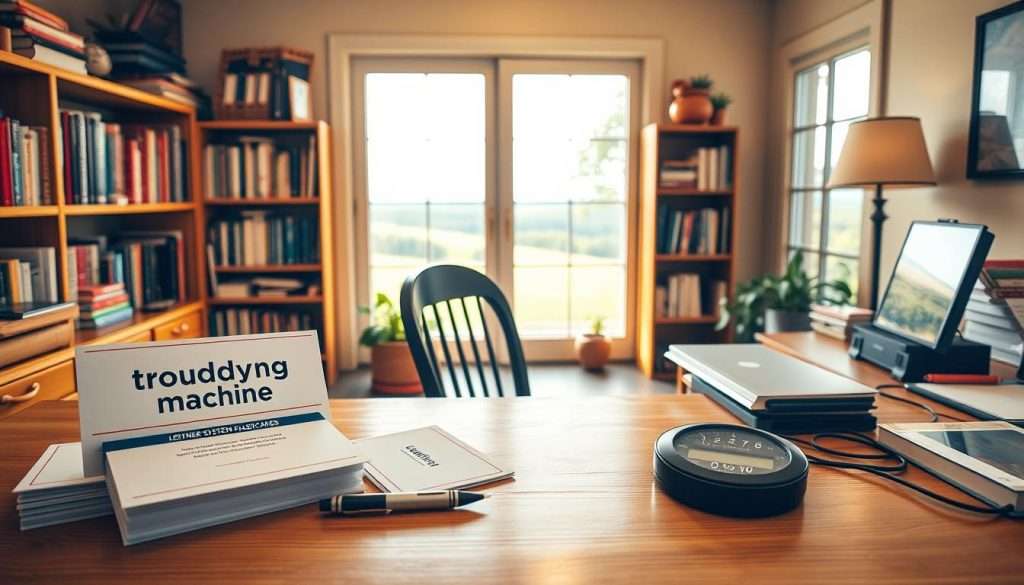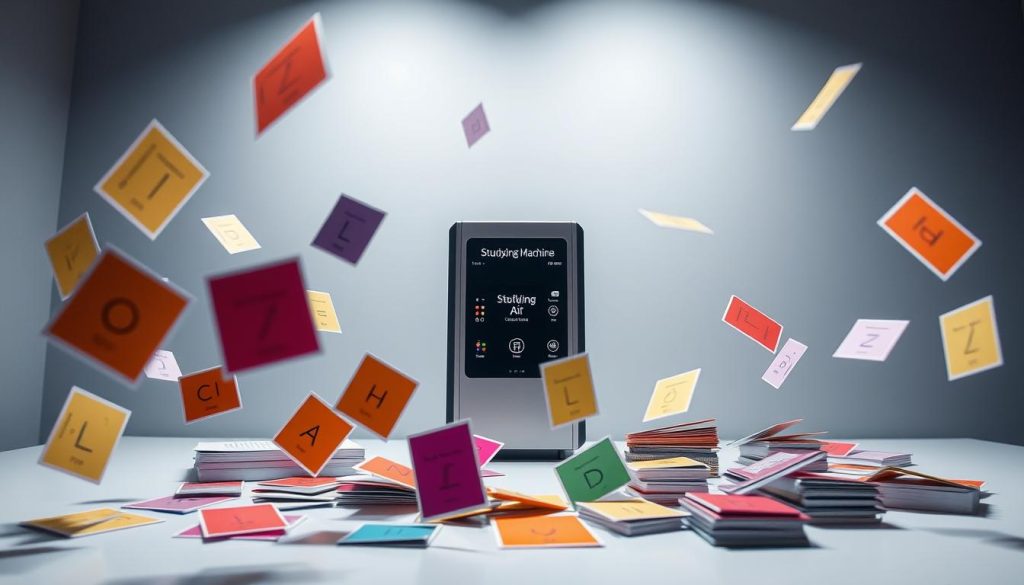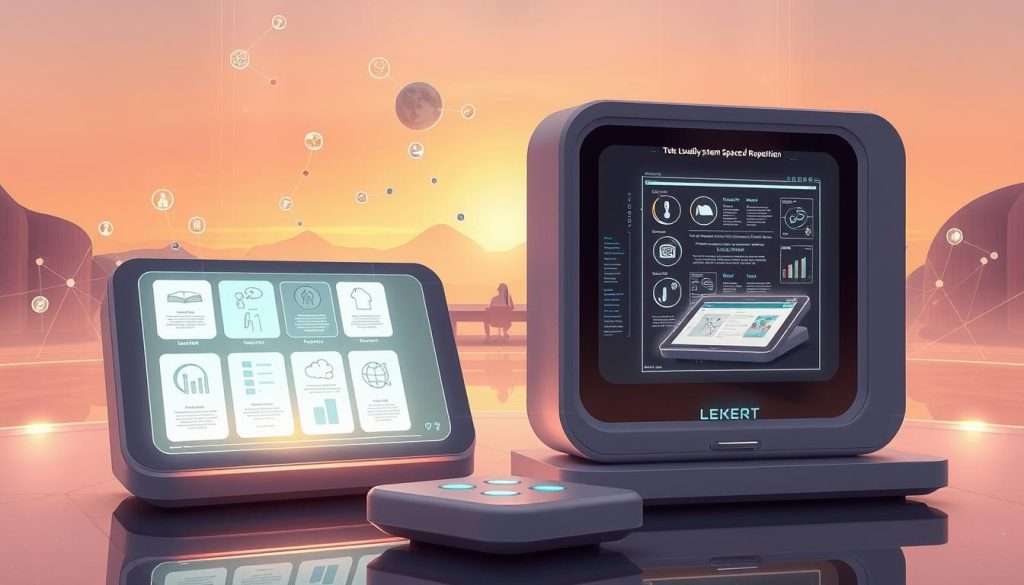Are you tired of cramming for exams, only to forget what you learned? Spaced repetition might be the solution. German psychologist Sebastian Leitner created the Leitner System in the 1970s. It’s a learning technique that boosts memory retention.
We’re going to explore the Leitner System, a method that enhances learning. By using spaced repetition, you can change how you learn and get better results.
Key Takeaways
- Understand the Leitner System and its benefits
- Learn how to implement spaced repetition in your study routine
- Improve your memory retention with effective learning techniques
- Discover how to revolutionize your learning with the Leitner System
- Achieve better results with a proven learning method
Understanding the Leitner System
Let’s explore the Leitner System, a great tool for learning. It’s a simple yet effective method. It uses flashcards and spaced repetition to help you remember things.
The Origins and Development by Sebastian Leitner
Sebastian Leitner, a German psychologist, created the Leitner System. He used spaced repetition to improve learning. This idea is based on the psychological spacing effect. It shows that learning in spaced sessions is better than all at once.
Core Principles of Spaced Repetition Learning
The Leitner System relies on spaced repetition. It uses the psychological spacing effect to improve memory. There are two main principles:
Memory Retention Science
Our brains learn and remember better with spaced reviews. This is because we naturally forget things over time. This is called the forgetting curve.
The Forgetting Curve
The forgetting curve shows how our memory fades over time. By using the Leitner System, we review at the best times. This helps us remember more.
| Review Interval | Retention Rate |
|---|---|
| Initial Review | 100% |
| First Spaced Repetition | 80% |
| Second Spaced Repetition | 90% |
By using the Leitner System, we can greatly improve our memory. It helps us beat the forgetting curve and learn better.
How the Leitner System Works in Practice
Now, let’s get into how the Leitner System works in real life. It’s a great tool for learning and remembering things. It uses a multi-box system to sort flashcards by how well you know them.
The Multi-Box System Explained
The heart of the Leitner System is its multi-box system. You put flashcards in different boxes based on how well you know them. This helps you focus on what you need to work on. You move cards between boxes based on how well you do during reviews.
Card Movement Rules and Intervals
The Leitner System is simple yet effective. Cards move boxes based on how well you do during reviews. If you get it right, the card goes to a box where it’s reviewed less. If you get it wrong, it stays or goes back to a harder box.
The Psychological Mechanisms at Work
The Leitner System uses psychology to help you learn better. Two main things happen:
Reinforcement Through Success
When you answer right, cards move to boxes where they’re reviewed less. This makes you feel good and helps you remember better.
Prioritizing Difficult Material
But if you struggle, cards stay or go back to boxes where they’re reviewed more. This means you practice more on what’s hard, making your study time count.
Understanding these mechanisms helps you use the Leitner System to its fullest. You’ll learn more efficiently and remember better.
Key Benefits of Mastering the Leitner System
Learning the Leitner System can change how you study. It makes studying more effective and less stressful. You’ll enjoy many benefits.
Enhanced Long-Term Memory Retention
The Leitner System helps you keep information in your long-term memory. It reviews material at longer intervals. This strengthens your understanding and keeps the info with you.
Efficient Study Time Management
This system helps you manage your study time better. You focus on what needs the most attention. This makes your study sessions more productive.
Self-Assessment and Progress Tracking
The Leitner System lets you track your progress easily. Moving cards through boxes shows how well you’re doing.
Reduced Cramming and Study Stress
It reduces cramming and study stress. By spreading out study sessions, you focus on what’s most important. This helps you avoid last-minute stress.
The Leitner System is a complete learning method. It improves your study habits and academic performance.
Step1: Setting Up Your Leitner System
Setting up the Leitner System is easier than you might think. We’re here to help you through it. First, you’ll need a few essential materials. These are simple to find and prepare.
Essential Materials Needed
To start the Leitner System, choose your box type. You can pick physical boxes or digital options.
Box Options and Alternatives
Physical boxes offer a hands-on experience. Digital options, like apps, are more flexible. “The key to success is sticking to what works for you,” experts say.
Card Selection and Preparation
Then, prepare your flashcards. These cards will be your study material. Make sure the info is short and to the point.
Creating Your Box Divisions
After preparing your materials, set up your box divisions. Use three to five boxes to track your progress.
Establishing Your Review Schedule
Lastly, create a review schedule. Choose how often to review based on your goals and the box transition intervals.
By following these steps, you’re on your way to a great Leitner System. Next, we’ll talk about making effective flashcards for learning.
Step2: Creating Effective Flashcards for Learning
Flashcards are key to the Leitner System. Making them effective is an art that needs focus. To improve your study sessions, create flashcards that are both informative and engaging.
Principles of High-Impact Flashcard Design
When making your flashcards, remember a few important points. First, keep it simple: don’t overload your cards with too much info. Second, use clear language: make sure your cards are easy to get. Lastly, make it memorable: use mnemonics or pictures to help remember important ideas.
Common Flashcard Creation Mistakes
One big mistake is making flashcards too complicated. This can confuse you and make studying harder. Another error is not being consistent in design. To avoid this, use a standard format for your flashcards and stick to it.
Subject-Specific Card Design Tips
Different subjects need different flashcard designs. For languages, include example sentences. For science and technical subjects, diagrams and illustrations are very helpful.
Text-Based vs. Visual Information
Think about whether to use text or pictures on your flashcards. For subjects that are very visual, like anatomy or complex machines, pictures are best.
Question Formulation Techniques
Creating good questions is key for useful flashcards. Try the Cloze deletion method. This involves removing a key term from a sentence, making you remember it when you review.
| Subject | Recommended Flashcard Content | Example |
|---|---|---|
| Languages | Vocabulary words, grammar rules, example sentences | “Bonjour” – Hello in French |
| Science/Technical | Diagrams, formulas, key terms | Diagram of the human heart |
| History | Dates, events, historical figures | 1776 – Year of American Declaration of Independence |
Step3: Implementing Your Daily Leitner System Routine
Starting your daily Leitner System routine is where the magic begins. Being consistent is key. A daily routine helps you use your study time wisely.
Initial Card Organization Process
First, sort your flashcards into boxes based on how well you know the material. Box 1 is for the most challenging cards. The other boxes are for cards you’ve learned more about. Sorting them well is important for your daily reviews.
Daily Review Protocol
Start with Box 1 each day. Try to recall the information on the back of each card. If you get it right, move the card to the next box. If not, it stays or goes back to an earlier box. Consistency is crucial; review at the same time every day.

Managing Card Progression Between Boxes
As you review, cards move between boxes based on how well you do. Hard cards stay or go back to earlier boxes. Easy ones move forward. This keeps you focused on what needs more work.
Troubleshooting Difficult Cards
Some cards are harder than others. Here are a few tips:
- Break down complex info into simpler parts
- Use mnemonic devices to help remember
Breaking Down Complex Concepts
For tough concepts, break them down into smaller parts. Make extra flashcards for specific parts of the concept.
Mnemonic Integration Strategies
Mnemonics are great for remembering hard stuff. Try different types like acronyms, rhymes, or pictures to see what works for you.
Stick to this daily routine and adjust it as needed. This way, you’ll get the most out of the Leitner System and reach your learning goals faster.
Adapting the Leitner System for Different Learning Goals
The Leitner System is great for learning new things. It works for languages and complex subjects. You can use it for many subjects and goals.
Language Acquisition Applications
It’s perfect for learning languages. You can make flashcards with words and their meanings. This helps you learn vocabulary and phrases.
Scientific and Technical Concept Mastery
It’s also good for science and tech. Make flashcards with key terms and their explanations. This helps you understand complex concepts.
Historical Facts and Chronology Learning
It’s useful for history too. Use flashcards for dates and events. This makes it easier to remember historical facts.
Mathematical and Formula-Based Learning
Math students can also benefit. Create flashcards with formulas and their solutions. This improves your understanding and recall of math.
| Subject | Flashcard Content | Benefits |
|---|---|---|
| Language Acquisition | Vocabulary words and translations | Improved vocabulary retention |
| Scientific Concepts | Key terms and explanations | Better understanding of complex concepts |
| Historical Facts | Events and corresponding dates | Enhanced chronology knowledge |
| Mathematical Formulas | Formulas and their applications | Increased problem-solving confidence |
By tailoring the Leitner System to your goals, you can get the most out of it. It helps you achieve your learning objectives.
Digital Tools and Apps for the Leitner System
Digital tools make the Leitner System more efficient. They upgrade the traditional flashcard method. This makes studying easier and more organized.
Top Spaced Repetition Software Options
Anki is a top choice for the Leitner System. It’s known for being flexible and customizable. Quizlet is also popular, with a user-friendly interface and lots of flashcards.
These tools help learners stay organized. They make sure study sessions are effective for retaining information.
Mobile Apps for On-the-Go Learning
Mobile apps change how we learn. They let us study anywhere, anytime. AnkiMobile and Memrise make studying easy with the Leitner System.
These apps have reminders and track your progress. They help you stay on schedule with your studies.
Features to Look for in Digital Leitner Tools
When picking a digital tool, look for these features:
Synchronization Capabilities
Syncing your data across devices is key. It means you can study on any device without hassle. This makes studying smooth and convenient.
Progress Analytics
Knowing your progress is crucial. Digital tools with analytics help you see where to improve. This boosts your learning efficiency.
Overcoming Common Leitner System Challenges
The Leitner System is a great tool for learning, but it faces challenges. To beat these, you need to be consistent and manage your study well. This will help you use the system to its fullest potential.
Maintaining Consistent Practice
To keep practicing regularly, set a schedule and follow it. Being consistent is essential for the Leitner System to work for you.
Managing Large Volumes of Study Material
Handling lots of study material can be tough. Divide your study material into smaller parts and sort them into groups. This makes it easier to handle.
Adjusting Difficulty and Intervals
Changing the difficulty and intervals of your flashcards is important. Keep reviewing and adjust the difficulty to keep challenging yourself.
Avoiding Common Implementation Pitfalls
- Don’t overfill your boxes; it can lead to burnout.
- Regularly review your progress to identify areas that need improvement.
- Be flexible with your system; adjust as needed to keep it effective.
Knowing these common challenges and how to solve them will help you use the Leitner System better. 
Advanced Leitner System Techniques and Modifications</h3>
As you get better at the Leitner System, you can try new techniques. These changes make the system fit your needs better. They also make studying more fun.
Custom Box Arrangements for Specific Needs
The Leitner System is very flexible. You can change the box setup to fit your learning style. For example, use a four-box system for memorization-heavy subjects. Use a three-box system for subjects that are more about understanding.
This customization helps you study smarter. It lets you focus on what you need to work on.
Hybrid Learning Method Integration
Mixing the Leitner System with other learning methods can really help. You can add active recall, mind mapping, or mnemonic devices to your flashcards. This hybrid approach makes learning complex stuff easier.
Try different mixes to see what works best for you.
Gamification Elements to Increase Motivation
Gamification makes studying fun and keeps you motivated. Adding game-like elements to your Leitner System makes learning more enjoyable.
Reward Systems
Setting up a reward system is a great way to stay motivated. Give yourself a treat for every box you finish or a certain number of cards reviewed. It could be something as simple as watching a funny video or enjoying a snack.
Competitive Learning Approaches
Turning studying into a competition can be very motivating. Challenge yourself to review a certain number of cards in a time limit. Or, race with a study buddy to see who can move through the boxes faster. This competitive edge makes studying more fun and productive.
Real-World Success Stories with the Leitner System
The Leitner System has changed how we learn, leading to amazing success stories around the world. It’s a spaced repetition method that helps people reach their learning goals. These goals can be in school, work, or personal growth.
Academic Achievement Transformations
Students who use the Leitner System see big improvements in school. They manage their study materials well and remember information better. This helps them do well on exams.
Professional Skill Development Cases
Professionals also benefit from the Leitner System. They use it to learn new skills or improve old ones. It’s great for keeping up with the latest in their field.
Polyglot Learning Journeys
Language learners find the Leitner System very helpful. It helps them review vocabulary and grammar. This way, they can become fluent more quickly.
Medical and Law Student Applications
Students in tough fields like medicine and law use the Leitner System too. It helps them remember a lot of information. This is key for their future success.
These stories show how effective the Leitner System is. It works for students, professionals, and anyone who wants to learn more. It can be adjusted to fit your needs, helping you reach your goals.
Conclusion: Transforming Your Learning Journey with the Leitner System
The Leitner System is a game-changer for learners. It boosts memory retention and study efficiency. Say goodbye to cramming and hello to a more enjoyable learning experience.
Now, it’s time to put the Leitner System into practice. Start by setting up your system and creating effective flashcards. Follow your daily routine. You’ll be amazed at how this technique can change your learning journey.
Take the first step today and see the difference the Leitner System can make. With consistent practice and patience, you’ll become more confident and capable.

